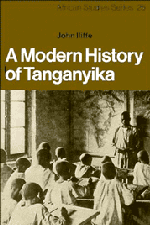Book contents
- Frontmatter
- Contents
- List of maps and tables
- Preface
- Acknowledgments
- Terminology
- Abbreviations
- Map I Tanganyika
- 1 Intentions
- 2 Tanganyika in 1800
- 3 The nineteenth century
- 4 The German conquest
- 5 Colonial economy and ecological crisis, 1890–1914
- 6 The Maji Maji rebellion, 1905–7
- 7 Religious and cultural change before 1914
- 8 Fortunes of war
- 9 The origins of rural capitalism
- 10 The creation of tribes
- 11 The crisis of colonial society, 1929–45
- 12 Townsmen and workers
- 13 The African Association, 1929–48
- 14 The new colonialism
- 15 The new politics, 1945–55
- 16 The nationalist victory, 1955–61
- Bibliography
- Index
16 - The nationalist victory, 1955–61
Published online by Cambridge University Press: 03 May 2011
- Frontmatter
- Contents
- List of maps and tables
- Preface
- Acknowledgments
- Terminology
- Abbreviations
- Map I Tanganyika
- 1 Intentions
- 2 Tanganyika in 1800
- 3 The nineteenth century
- 4 The German conquest
- 5 Colonial economy and ecological crisis, 1890–1914
- 6 The Maji Maji rebellion, 1905–7
- 7 Religious and cultural change before 1914
- 8 Fortunes of war
- 9 The origins of rural capitalism
- 10 The creation of tribes
- 11 The crisis of colonial society, 1929–45
- 12 Townsmen and workers
- 13 The African Association, 1929–48
- 14 The new colonialism
- 15 The new politics, 1945–55
- 16 The nationalist victory, 1955–61
- Bibliography
- Index
Summary
The United Tanganyika Party
‘When Julius Nyerere…set up Tanu’, Governor Twining later recalled, ‘I read his original Manifesto very carefully. It demanded that Africa should be for the Africans, Tanganyika for the black Tanganyikans. We Europeans were not even allowed to join. This policy of black racialism was contrary to the principles of the Trusteeship Agreement and to the policy of the British Government.’ In order to establish multi-racialism in Kenya and Central Africa, Britain was prepared to impose it also on Tanganyika where immigrant races were less important. It was not necessarily intended to be a permanent arrangement – this remains unknown – but it meant neglecting Tanganyika's preparation for independence. In August 1955 Twining met the Colonial Secretary, Alan Lennox-Boyd. No record of their discussion is yet available, but Lennox-Boyd probably approved a campaign against TANU. To lead it Twining chose Ivor Bayldon, leader of the thirty unofficials – ten from each race – appointed to the Legislative Council in March 1955. Most of these unofficials signed the announcement of the United Tanganyika Party's formation in February 1956. The party aimed ‘to build up a non-racial Tanganyika nation’, self-governing within the Commonwealth, by extending the franchise slowly to wealthier, better educated, and more responsible Africans, taking care that no one race predominated. The party's structure was modelled on the British Conservative Party, with a former Conservative Party official, Brian Willis, as General Director.
- Type
- Chapter
- Information
- A Modern History of Tanganyika , pp. 521 - 576Publisher: Cambridge University PressPrint publication year: 1979

